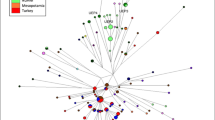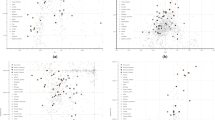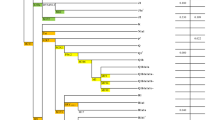Abstract
Cultural expansions, including of religions, frequently leave genetic traces of differentiation and in-migration. These expansions may be driven by complex doctrinal differentiation, together with major population migrations and gene flow. The aim of this study was to explore the genetic signature of the establishment of religious communities in a region where some of the most influential religions originated, using the Y chromosome as an informative male-lineage marker. A total of 3139 samples were analyzed, including 647 Lebanese and Iranian samples newly genotyped for 28 binary markers and 19 short tandem repeats on the non-recombinant segment of the Y chromosome. Genetic organization was identified by geography and religion across Lebanon in the context of surrounding populations important in the expansions of the major sects of Lebanon, including Italy, Turkey, the Balkans, Syria, and Iran by employing principal component analysis, multidimensional scaling, and AMOVA. Timing of population differentiations was estimated using BATWING, in comparison with dates of historical religious events to determine if these differentiations could be caused by religious conversion, or rather, whether religious conversion was facilitated within already differentiated populations. Our analysis shows that the great religions in Lebanon were adopted within already distinguishable communities. Once religious affiliations were established, subsequent genetic signatures of the older differentiations were reinforced. Post-establishment differentiations are most plausibly explained by migrations of peoples seeking refuge to avoid the turmoil of major historical events.
Similar content being viewed by others
Log in or create a free account to read this content
Gain free access to this article, as well as selected content from this journal and more on nature.com
or
References
El-Sibai M, Platt DE, Haber M et al: Geographical structure of the Y-chromosomal genetic landscape of the Levant: a coastal–inland contrast. Ann Hum Genet 2009; 73: 568–581.
Zalloua PA, Platt DE, El Sibai M et al: Identifying genetic traces of historical expansions: phoenician footprints in the Mediterranean. Am J Hum Genet 2008; 83: 633–642.
Zalloua PA, Xue Y, Khalife J et al: Y-chromosomal diversity in Lebanon is structured by recent historical events. Am J Hum Genet 2008; 82: 873–882.
Glass B, Sacks MS, Jahn EF, Hess C : Genetic drift in a religious isolate: an analysis of the causes of variation in blood group and other gene frequencies in a small population. Am Naturalist 1952; 86: 145–159.
McKusick VA : Ellis–van Creveld syndrome and the Amish. Nat Genet 2000; 24: 203–204.
Morton DH, Morton CS, Strauss KA et al: Pediatric medicine and the genetic disorders of the Amish and Mennonite people of Pennsylvania. Am J Med Genet C 2003; 121C: 5–17.
Newman DL, Abney M, Dytch H, Parry R, McPeek MS, Ober C : Major loci influencing serum triglyceride levels on 2q14 and 9p21 localized by homozygosity-by-descent mapping in a large Hutterite pedigree. Hum Mol Genet 2003; 12: 137–144.
Ober C, Bombard A, Dhaliwal R et al: Studies of cystic fibrosis in Hutterite families by using linked DNA probes. Am J Hum Genet 1987; 41: 1145–1151.
Ober C, Elias S, Kostyu DD, Hauck WW : Decreased fecundability in Hutterite couples sharing HLA-DR. Am J Hum Genet 1992; 50: 6–14.
Ober C, Elias S, O'Brien E, Kostyu DD, Hauck WW, Bombard A : HLA sharing and fertility in Hutterite couples: evidence for prenatal selection against compatible fetuses. Am J Reprod Immunol Microbiol 1988; 18: 111–115.
Pichler I, Fuchsberger C, Platzer C et al: Drawing the history of the Hutterite population on a genetic landscape: inference from Y-chromosome and mtDNA genotypes. Eur J Hum Genet 2009.
Bosch E, Calafell F, Comas D, Oefner PJ, Underhill PA, Bertranpetit J : High-resolution analysis of human Y-chromosome variation shows a sharp discontinuity and limited gene flow between northwestern Africa and the Iberian Peninsula. Am J Hum Genet 2001; 68: 1019–1029.
Plaza S, Calafell F, Helal A et al: Joining the pillars of Hercules: mtDNA sequences show multidirectional gene flow in the western Mediterranean. Ann Hum Genet 2003; 67: 312–328.
Lammens H : Tasrih al-Absar fi ma Yahtawi Lebnan min al-Athar. al-Mashriq: Beirut, 1902.
Moosa M : The Maronites in History. New York: Syracuse University Press, 1986.
Jobling MA, Tyler-Smith C : The human Y chromosome: an evolutionary marker comes of age. Nat rev 2003; 4: 598–612.
Hitti P : Lebanon in History from the Earliest Times to the Present. London: Macmillan, 1957.
Cinnioglu C, King R, Kivisild T et al: Excavating Y-chromosome haplotype strata in Anatolia. Hum Genet 2004; 114: 127–148.
Bosch E, Calafell F, Gonzalez-Neira A et al: Paternal and maternal lineages in the Balkans show a homogeneous landscape over linguistic barriers, except for the isolated Aromuns. Ann Hum Genet 2006; 70: 459–487.
Onofri V, Alessandrini F, Turchi C et al: Y-chromosome genetic structure in sub-Apennine populations of Central Italy by SNP and STR analysis. Int J Legal Med 2007; 121: 234–237.
Jolliffe I : Principal Components Analysis, Second Edition, 2 edn. New York, NY: Springer, 1986.
Excoffier L, Smouse PE, Quattro JM : Analysis of molecular variance inferred from metric distances among DNA haplotypes: application to human mitochondrial DNA restriction data. Genetics 1992; 131: 479–491.
Excoffier L, Laval G, Schneider S : Arlequin (version 3.0): an integrated software package for population genetics data analysis. Evol Bioinform Online 2005; 1: 47–50.
Kruskal JB : Multidimensional scaling by optimizing goodness of fit to a nonmetric hypothesis. Psychometrika 1964; 29: 1–27.
Takahata N, Nei M : F and G statistics in the Finite Island Model. Genetics 1984; 107: 501–504.
Latter BD : The island model of population differentiation: a general solution. Genetics 1973; 73: 147–157.
Bandelt HJ, Forster P, Sykes BC, Richards MB : Mitochondrial portraits of human populations using median networks. Genetics 1995; 141: 743–753.
Xue Y, Zerjal T, Bao W et al: Male demography in East Asia: a north–south contrast in human population expansion times. Genetics 2006; 172: 2431–2439.
Zhivotovsky LA, Underhill PA, Cinnioglu C et al: The effective mutation rate at Y chromosome short tandem repeats, with application to human population-divergence time. Am J Hum Genet 2004; 74: 50–61.
Sturrock K, Rocha J : A multidimensional scaling stress evaluation table. Field Methods 2000; 12: 49–60.
Acknowledgements
We thank the sample donors for taking part in this study. YX and CTS are supported by The Wellcome Trust. The Genographic Project is supported by funding from the National Geographic Society, IBM, and the Waitt Family Foundation.
Author information
Authors and Affiliations
Consortia
Corresponding author
Ethics declarations
Competing interests
The authors declare no conflict of interest.
Additional information
Supplementary Information accompanies the paper on European Journal of Human Genetics website
Appendix
Appendix
The Genographic Consortium
Syama Adhikarla1, Christina J Adler2, Elena Balanovska3, Oleg Balanovsky3, Jaume Bertranpetit4, Andrew C Clarke5, David Comas4, Alan Cooper2, Clio SI Der Sarkissian2, Matthew C Dulik6, Christoff J Erasmus7, Jill B Gaieski6, ArunKumar GaneshPrasad1, Wolfgang Haak2, Angela Hobbs7, Asif Javed8, Li Jin9, Matthew E Kaplan10, Shilin Li9, Begoña Martínez-Cruz4, Elizabeth A Matisoo-Smith5, Marta Melé4, Nirav C Merchant10, R John Mitchell11, Amanda C Owings6, Laxmi Parida8, Ramasamy Pitchappan1, Lluis Quintana-Murci12, Colin Renfrew13, Daniela R Lacerda14, Fabrício R Santos14, Theodore G Schurr6, Himla Soodyall7, Pandikumar Swamikrishnan15, Kavitha Valampuri John1, Arun Varatharajan Santhakumari1, Pedro Paulo Vieira16, Janet S Ziegle17
Affiliations for participants: 1Madurai Kamaraj University, Madurai, Tamil Nadu, India; 2University of Adelaide, South Australia, Australia; 3Research Centre for Medical Genetics, Russian Academy of Medical Sciences, Moscow, Russia; 4Universitat Pompeu Fabra, Barcelona, Spain; 5University of Otago, Dunedin, New Zealand; 6University of Pennsylvania, Philadelphia, PA, USA; 7National Health Laboratory Service, Johannesburg, South Africa; 8IBM, Yorktown Heights, NY, USA; 9Fudan University, Shanghai, China; 10University of Arizona, Tucson, AZ, USA; 11La Trobe University, Melbourne, Victoria, Australia; 12Institut Pasteur, Paris, France; 13University of Cambridge, Cambridge, UK; 14Universidade Federal de Minas Gerais, Belo Horizonte, Minas Gerais, Brazil; 15IBM, Somers, NY, USA; 16Universidade Federal do Rio de Janeiro, Rio de Janeiro, Brazil; 17Applied Biosystems, Foster City, CA, USA.
Rights and permissions
About this article
Cite this article
Haber, M., Platt, D., Badro, D. et al. Influences of history, geography, and religion on genetic structure: the Maronites in Lebanon. Eur J Hum Genet 19, 334–340 (2011). https://doi.org/10.1038/ejhg.2010.177
Received:
Revised:
Accepted:
Published:
Issue date:
DOI: https://doi.org/10.1038/ejhg.2010.177
Keywords
This article is cited by
-
Assessment of the effectiveness of the EUROFORGEN NAME and Precision ID Ancestry panel markers for ancestry investigations
Scientific Reports (2021)
-
Dispersals of the Siberian Y-chromosome haplogroup Q in Eurasia
Molecular Genetics and Genomics (2018)
-
Phylogeography of human Y-chromosome haplogroup Q3-L275 from an academic/citizen science collaboration
BMC Evolutionary Biology (2017)
-
The Connection of the Genetic, Cultural and Geographic Landscapes of Transoxiana
Scientific Reports (2017)
-
Mapping Post-Glacial expansions: The Peopling of Southwest Asia
Scientific Reports (2017)



